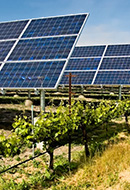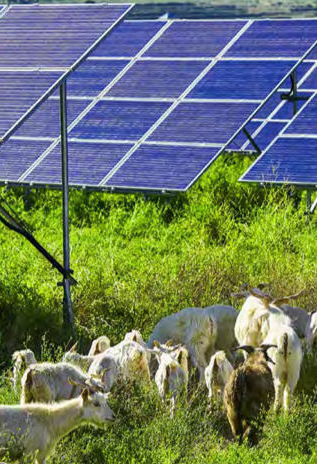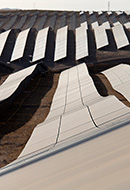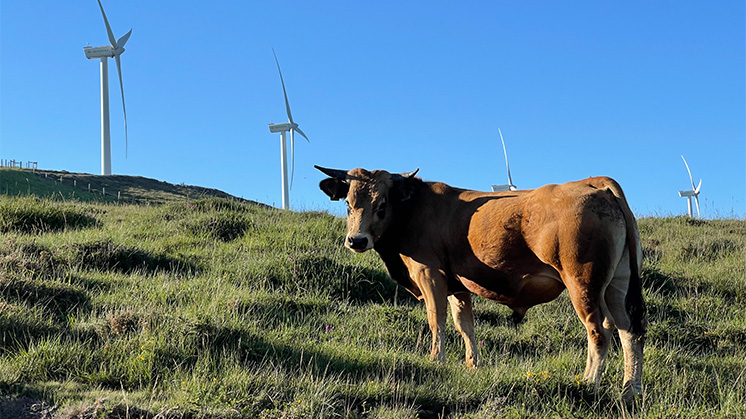Renewable energies in agriculture
Use of renewable energies in agriculture and livestock farming
The coexistence between crops or pastures and renewable installations is becoming increasingly widespread and is moving towards a sustainable relationship with mutual benefits for both sectors. Various projects such as agrovoltaic projects generate spaces of coexistence between energy production, the promotion of the local economy and the protection of biodiversity.
The detrimental impact of climate change - mainly driven by the burning of fossil fuels - on nature and biodiversity is more than evident: its consequences disrupt biological processes and degenerate our planet's ecosystems. Increasing the production of renewable energies is essential to mitigate its effects and achieve the desired energy transition towards the decarbonisation of the economy. This type of energy has received significant support from the international community following the Paris Agreement signed at the World Climate Summit in December 2015.
However, experts agree on the need for a careful and precise expansion of renewable energies to avoid further damage to biodiversity. Decarbonisation and the preservation of biodiversity need not be at odds with each other, and together they can even contribute to reducing the environmental impact generated by the agricultural sector.
Advantages of the coexistence of renewables and the primary sector
The coexistence between primary sector activities and renewable installations is increasingly present, with important links to generate a more sustainable connection. The result? All sectors benefit from each other. Here are some of the advantages:
 Less space for efficient production
Less space for efficient production
The combined use of the land improves its yield, as energy and agricultural products are produced in the same space.
 Greenhouse gas emissions are reduced
Greenhouse gas emissions are reduced
The convergence of energy and agricultural production makes it possible to achieve sustainable production. It also relieves pressure on ecosystems and biodiversity, which are the first to be affected when cultivation areas are expanded.
 Self-sufficiency
Self-sufficiency
On-site renewables allow for the promotion of self-consumption. Farms and livestock farms can use the energy generated by the power plants with a consequent reduction in electricity consumption costs.
 Boosting local employment
Boosting local employment
The cohesion between renewables and rural development revalues traditional activities and stimulates the development of local businesses directly or indirectly related to the energy sector.

Agrovoltaics
When agriculture and renewables go hand in hand.

Wine sector and solar energy
How is technology helping to protect the wine sector from climate change?

Biodiversity protection
We protect and preserve biodiversity on some of our projects.

Decarbonisation
Regulatory principles and actions that contribute to a sustainable and efficient framework.
Projects to preserve biodiversity
Iberdrola is committed to the conservation of biodiversity, a challenge that it integrates into its strategy in order to achieve a net positive impact by 2030. Through various initiatives, the company demonstrates that it is possible to efficiently and sustainably combine the supply of renewable energy and environmental balance.
As a materialisation of this commitment, Iberdrola and the Agricultural Association of Young Farmers (ASAJA) signed a strategic alliance in 2021 to promote sustainable agriculture and livestock farming in Spain. The work plan includes two vectors: the promotion of actions aimed at improving energy efficiency and the promotion of initiatives to continue preserving biodiversity and care for the rural environment.
Agrovoltaic energy, an example of coexistence
Agrovoltaic energy, also known as agro-photovoltaics, consists of using part of a plot of land to obtain both solar energy and agricultural products. In other words, photovoltaic plants coexist with fruit, vegetables and cereal crops, among others. The aim is to achieve sustainable agriculture.
Various studies estimate that the electricity generated by solar panels increases the economic value of agrovoltaic farms by more than 30 % by improving the efficiency and yield of the land. In other words, the output of both sectors is considerable while occupying less space.
Agrovoltaic energy and its efficiency
Thanks to the combined application of agriculture and photovoltaics, the landuse efficiency of the agrovoltaic system can reach 186%.
Separate use of agricultural land
1 hectare of crops
1 hectare of solar panels

100% agricultural product

100% solar electricity
Combined use of agricultural land
1 hectare of crops
and solar panels
Technological innovation accelerates the sustainable use that this type of installation promises. One of the most obvious examples is the Winesolar project, the first smart agrovoltaic plant in Spain that Iberdrola launched in 2022. This initiative was one of the four winners of the NewTech Challenge launched in 2021 through PERSEO, Iberdrola's international start-up programme.
Located in the town of Guadamur (Spain), the innovative installation has trackers controlled by an artificial intelligence algorithm. The arrangement of the modules is adapted to the needs of the vines, to regulate the incidence of the sun and the temperature by means of the shade of the panels.
The production of this pilot plant, with a capacity of 40 kW, will be used entirely for self-consumption by the González Byass and Grupo Emperador wineries, which will be able to promote sustainable viticulture and reduce their emissions.
Renewables and livestock farming: a beneficial union
The benefits of the combination of renewable energies and livestock farming are extensive. On the one hand, livestock farmers benefit from the presence of extensive grazing fields, where their animals can feed safely. And the vegetation surrounding the power installations is free of pesticides and other chemicals. In addition, the shade that structures such as photovoltaic structures cast on the ground provide good space for animals to shelter from direct sun, rain or wind.
On the other hand, energy producers are assured of land maintenance. Grazing allows for the control of vegetation growth, for example, in the case of sheep herds that remove weeds and avoid the use of machinery.
More than 1,200 sheep graze on the grounds of the Núñez de Balboa photovoltaic plant (Spain), allowing the plant species to grow in rotation. A space where nature, livestock and solar production coexist. During the hottest months, the animals are accommodated in the shade of the panels.
Other initiatives focused on rural development
The combination of renewable energy production plants with activities related to the countryside extends beyond agriculture and livestock farming to other activities such as beekeeping or the cultivation of aromatic herbs.
Iberdrola has already installed more than 300 hives in photovoltaic installations in southern Spain, such as Nuñez de Balboa (Badajoz) and Andévalo (Huelva). These initiatives generate ecological zones that allow the study of how the cultivation of aromatic plants - such as eucalyptus, rosemary or thyme - increases the quality of honey. In fact, in 2022, part of this ecological product produced in the Campo Arañuelo III photovoltaic plant (Cáceres) was harvested for the first time. This, like the rest of the projects, generates sustainable ecosystems and a beneficial combination for the environment.






